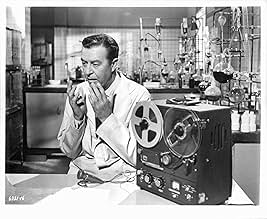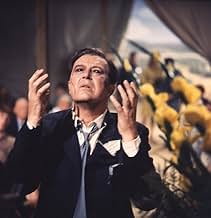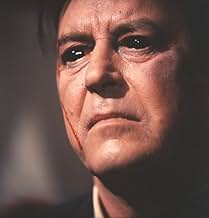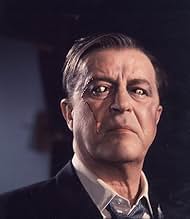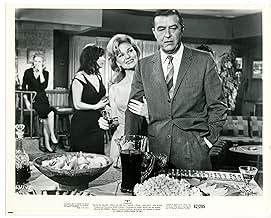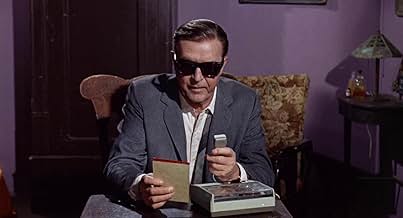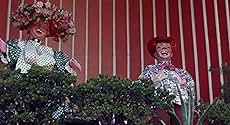VALUTAZIONE IMDb
6,6/10
8808
LA TUA VALUTAZIONE
Un medico usa speciali colliri per darsi la visione a raggi X, ma il nuovo potere ha conseguenze disastrose.Un medico usa speciali colliri per darsi la visione a raggi X, ma il nuovo potere ha conseguenze disastrose.Un medico usa speciali colliri per darsi la visione a raggi X, ma il nuovo potere ha conseguenze disastrose.
- Regia
- Sceneggiatura
- Star
- Premi
- 2 candidature totali
Diana Van der Vlis
- Dr. Diane Fairfax
- (as Diana van der Vlis)
Budd Albright
- Dance sequence
- (non citato nei titoli originali)
Leon Alton
- Casino Patron
- (non citato nei titoli originali)
Morris Ankrum
- Mr. Bowhead
- (non citato nei titoli originali)
Benjie Bancroft
- Dealer
- (non citato nei titoli originali)
George DeNormand
- Medical Board Member
- (non citato nei titoli originali)
John Dierkes
- Preacher
- (non citato nei titoli originali)
Bobby Gilbert
- Man Outside Office
- (non citato nei titoli originali)
Stuart Hall
- Casino Patron
- (non citato nei titoli originali)
Kathryn Hart
- Mrs. Mart
- (non citato nei titoli originali)
Ed Haskett
- Casino Patron
- (non citato nei titoli originali)
Jonathan Haze
- Heckler
- (non citato nei titoli originali)
Harvey Jacobson
- Casino Boss
- (non citato nei titoli originali)
Vicki Lee
- Young Girl Patient
- (non citato nei titoli originali)
Recensioni in evidenza
RELEASED IN 1963 and directed by Roger Corman, "X: The Man with the X-Ray Eyes" chronicles events in Los Angeles when a doctor (Ray Milland) develops a formula that grants x-ray vision, which derails his career and forces him to join a carnival, using his new power to make a living. Diana Van der Vlis plays his disciple while Don Rickles is on hand as a carnival barker.
The early 60's vibe is to die for, but the beginning is rather dull. Things perk up at an adult party where the aging doctor tries to keep hip and eventually sees everyone nakkid (lol). The carnival sequence and what it leads into are arguably the best parts, although the Vegas and tent revival episodes have their attractions. The movie scores meh on the female front, but Lorrie Summers and Cathie Merchant have small parts.
THE MOVIE RUNS 1 hour 19 minutes and was shot in Los Angeles, California & Las Vegas, Nevada. WRITERS: Robert Dillon and Ray Russell. ADDITIONAL CAST: Harold J. Stone and John Hoyt play colleagues of the doctor.
GRADE: B-
The early 60's vibe is to die for, but the beginning is rather dull. Things perk up at an adult party where the aging doctor tries to keep hip and eventually sees everyone nakkid (lol). The carnival sequence and what it leads into are arguably the best parts, although the Vegas and tent revival episodes have their attractions. The movie scores meh on the female front, but Lorrie Summers and Cathie Merchant have small parts.
THE MOVIE RUNS 1 hour 19 minutes and was shot in Los Angeles, California & Las Vegas, Nevada. WRITERS: Robert Dillon and Ray Russell. ADDITIONAL CAST: Harold J. Stone and John Hoyt play colleagues of the doctor.
GRADE: B-
Here is Corman at almost his best. Ray Milland was as good an actor as Vincent Price, and this story isn't trapped in the Poe mode of rotting flesh and dilapidated mansions. It's more in the manner of Corman's The Trip, which was made a few years later. Dr. Xavier discovers something that he can use to see through solid objects, but its effect is cumulative, and by the end of the movie he's seeing all the way to the core of reality.
Of course, he has to go on the run, and must abandon his medical career. We see him in a carnival, reading peoples' thoughts, and later teaming up with his x girlfriend and going to Vegas and seeing through the cards and winning big, and finally, escaping from the police, and as he drives through the Nevada desert, we see that he can't see a thing. Abandoning his Lincoln Continental, he stumbles into a tent revival meeting. The preacher, played by Royal Dano(?)is telling his followers to throw Satan out. Filmed by Floyd Crosby, with beautiful special effects, this is a real piece of 60's film-making by one of the masters.
Of course, he has to go on the run, and must abandon his medical career. We see him in a carnival, reading peoples' thoughts, and later teaming up with his x girlfriend and going to Vegas and seeing through the cards and winning big, and finally, escaping from the police, and as he drives through the Nevada desert, we see that he can't see a thing. Abandoning his Lincoln Continental, he stumbles into a tent revival meeting. The preacher, played by Royal Dano(?)is telling his followers to throw Satan out. Filmed by Floyd Crosby, with beautiful special effects, this is a real piece of 60's film-making by one of the masters.
This was the typically-hokey-but fun Roger Corman film but one that keeps your interest most the way and at least stars a famous classic-era actor: Ray Milland. One actually wonders what an actor of Milland's status would doing in a B Grade B-type sci-fi movie like this. For someone who had admired Milland's work for many years, it just seems odd for me to see him in a small-budget film. Maybe things got tough for him near the end of his career and he would take most any role. I don't know, and I'm not judging.....just curious why he took this role. I do know having him in the movie elevates it and the dialog isn't as cheesy as one would expect in a 1950-ish sci-fi horror story made in the '60s.
Comedian Don Rickles playing a greedy criminal guy was another odd cast selection, but, he, too, was fun to watch.
Corman was smart to keep this at a respectable 79 minutes. Had it gone on longer, it would have started to drag. It would be interesting to see this film done with today's special-effects.
Comedian Don Rickles playing a greedy criminal guy was another odd cast selection, but, he, too, was fun to watch.
Corman was smart to keep this at a respectable 79 minutes. Had it gone on longer, it would have started to drag. It would be interesting to see this film done with today's special-effects.
To this writer, the film is Roger Corman's best entry into sci-fi. Many of his 50s efforts hold a certain campy charm, with their low-budget effects - and this film is similar in that regard. It does not dwell on the effects, in fact some of them are rather poor. What it does have in its favor is a tight screenplay that gets into the story quickly, as will the viewer - and it's engrossing enough and the characters interesting enough that one stays involved through the episodic story.
What it has most in its favor is an excellent performance from Ray Milland, then in his last days being top-billed, and he milks it for all that it's worth. In some scenes Corman goes for a direct close-up and Milland's facial reactions indicate that he took the the role in a small-budget/tight schedule film with all the enthusiasm that he did in one of his roles for Alfred Hitchcock ("Dial M For Murder") or Fritz Lang ("Ministry of Fear"). Smooth, refined, but a man of immediate action if necessary, Milland's Dr. Xavier is not your usual mad scientist. As with Claude Rains in "The Invisible Man" or Al Hedison in "The Fly" he's the scientist who made the mistake of being his own subject.
Occasionally Corman goes for the cheap gag (the party sequence, where Xavier examines the guests sans attire - but inoffensive in a typical 60s approach), but the carnival scenes and the basement healer scenes show a maturity to Corman's direction, and these scenes are greatly helped by the performance of Don Rickles. He's as sleazy as one can get and admits that if he had the power, he would use it to see "all the undressed women my poor eyes can stand" and you believe it. A scene where Milland confronts other carnival workers who are speculating on his "power" shows the doctor to be both introspective and world weary at the same time. At this point even he does not know what to do with his ability, but Rickles' suggestion of setting up a site to "heal" others leads to the film's most revealing and almost poetic sequence. Xavier's original intention was to help the ill, but his implication in an accidental murder led him to seek refuge in the carnival Richard Kimble-style.
Diana Van Der Vlis does well with her underwritten role in which at one point she's rather quickly dropped, and then resurfaces rather conveniently later in the story - to no great effect. This was only her second feature film, though she had done a number of TV guest shots. Although half Milland's age, she seems more mature than her 28 years and they make a believable pair. A bonus is the appearance of a number of veterans in brief roles - John Hoyt, Harold J. Stone, John Dierkes and Morris Ankrum, as well as Corman stalwart Dick Miller. Miller shares his scenes with Jonathan Haze, whom it appears was getting the cheapest rate Corman could pay as he has no lines at all. He was rather bitter about this as he revealed in an interview years later.
Floyd Crosby's cinematography belies the small budget - only $300,000 and a shooting schedule of about three weeks. According to Corman they did rehearse a bit more than usual - and in the finished product it shows. He claims he even went as high as four takes, which may not exactly put him in William Wyler or Stanley Kubrick territory, but it's a far cry from what he'd do in the 50s. Les Baxter contributes what may be my favorite of his scores, fully complimentary to the action on screen without overwhelming it.
There's a bit of controversy over the ending - some attribute an extra line of dialog that never appeared in any print that I've seen, but it is still one of the most surprising endings of any sci-fi film since "The Incredible Shrinking Man." That it won the top prize at the Trieste Science Fiction Film Festival would be enough for one to be curious enough to see it even this many years later - that it has held up so well over 40 years points to that award's validity.
What it has most in its favor is an excellent performance from Ray Milland, then in his last days being top-billed, and he milks it for all that it's worth. In some scenes Corman goes for a direct close-up and Milland's facial reactions indicate that he took the the role in a small-budget/tight schedule film with all the enthusiasm that he did in one of his roles for Alfred Hitchcock ("Dial M For Murder") or Fritz Lang ("Ministry of Fear"). Smooth, refined, but a man of immediate action if necessary, Milland's Dr. Xavier is not your usual mad scientist. As with Claude Rains in "The Invisible Man" or Al Hedison in "The Fly" he's the scientist who made the mistake of being his own subject.
Occasionally Corman goes for the cheap gag (the party sequence, where Xavier examines the guests sans attire - but inoffensive in a typical 60s approach), but the carnival scenes and the basement healer scenes show a maturity to Corman's direction, and these scenes are greatly helped by the performance of Don Rickles. He's as sleazy as one can get and admits that if he had the power, he would use it to see "all the undressed women my poor eyes can stand" and you believe it. A scene where Milland confronts other carnival workers who are speculating on his "power" shows the doctor to be both introspective and world weary at the same time. At this point even he does not know what to do with his ability, but Rickles' suggestion of setting up a site to "heal" others leads to the film's most revealing and almost poetic sequence. Xavier's original intention was to help the ill, but his implication in an accidental murder led him to seek refuge in the carnival Richard Kimble-style.
Diana Van Der Vlis does well with her underwritten role in which at one point she's rather quickly dropped, and then resurfaces rather conveniently later in the story - to no great effect. This was only her second feature film, though she had done a number of TV guest shots. Although half Milland's age, she seems more mature than her 28 years and they make a believable pair. A bonus is the appearance of a number of veterans in brief roles - John Hoyt, Harold J. Stone, John Dierkes and Morris Ankrum, as well as Corman stalwart Dick Miller. Miller shares his scenes with Jonathan Haze, whom it appears was getting the cheapest rate Corman could pay as he has no lines at all. He was rather bitter about this as he revealed in an interview years later.
Floyd Crosby's cinematography belies the small budget - only $300,000 and a shooting schedule of about three weeks. According to Corman they did rehearse a bit more than usual - and in the finished product it shows. He claims he even went as high as four takes, which may not exactly put him in William Wyler or Stanley Kubrick territory, but it's a far cry from what he'd do in the 50s. Les Baxter contributes what may be my favorite of his scores, fully complimentary to the action on screen without overwhelming it.
There's a bit of controversy over the ending - some attribute an extra line of dialog that never appeared in any print that I've seen, but it is still one of the most surprising endings of any sci-fi film since "The Incredible Shrinking Man." That it won the top prize at the Trieste Science Fiction Film Festival would be enough for one to be curious enough to see it even this many years later - that it has held up so well over 40 years points to that award's validity.
... in that a doctor makes a great discovery -in this case a formula that allows people to "see through" objects, starts out trying to do good, becomes his own guinea pig, becomes obsessed, becomes bitter because others do not see the importance of his discovery, and in the end just makes a bunch of stupid decisions. Oh, and the formula is cumulative and yet the doctor keeps taking it!
This film would be completely unmemorable without Ray Milland as the title character - Dr. Xavier. Like with his other horror films, independent producer/director Roger Corman smartly uses a lead from the golden age of Hollywood - in this case Milland - and builds a simple story that still strikes at the essence of fear in human beings.
There are a quite a few goofy and outright dumb things going on.When Xavier goes on the run because of a tragic accident, he ... decides to work as a "seer" in a carnival?? Isn't that one of the first places the police might come looking for him? In his quest for money to look for a "cure" for his situation, he decides to go to Vegas. And win a bunch of money in just one casino. And get a loud and obnoxious attitude about it. Maybe the most tragic thing about Xavier's situation is that he is inflicted with the company of Don Rickles during the mid part of the film.
The one fun and light hearted moment of the film is when Xavier is invited to a swinging 60s party and because of his unique condition sees naked people everywhere. Roger Corman will need to wait a few more years into the 60s before he can feature actual naked people. But I digress.
The special effects are laughable in the 21st century, but Milland's distinguished and empathetic presence makes this work. And it goes after the question - If you can see through EVERYTHING, what exactly DO you see?
This film would be completely unmemorable without Ray Milland as the title character - Dr. Xavier. Like with his other horror films, independent producer/director Roger Corman smartly uses a lead from the golden age of Hollywood - in this case Milland - and builds a simple story that still strikes at the essence of fear in human beings.
There are a quite a few goofy and outright dumb things going on.When Xavier goes on the run because of a tragic accident, he ... decides to work as a "seer" in a carnival?? Isn't that one of the first places the police might come looking for him? In his quest for money to look for a "cure" for his situation, he decides to go to Vegas. And win a bunch of money in just one casino. And get a loud and obnoxious attitude about it. Maybe the most tragic thing about Xavier's situation is that he is inflicted with the company of Don Rickles during the mid part of the film.
The one fun and light hearted moment of the film is when Xavier is invited to a swinging 60s party and because of his unique condition sees naked people everywhere. Roger Corman will need to wait a few more years into the 60s before he can feature actual naked people. But I digress.
The special effects are laughable in the 21st century, but Milland's distinguished and empathetic presence makes this work. And it goes after the question - If you can see through EVERYTHING, what exactly DO you see?
Lo sapevi?
- QuizTo create the effect of being able to see through a building, the director filmed the building while it was under construction.
- BlooperThe first X-ray that Dr. Xavier quizzes Dr. Fairfax with is a normal chest X-ray. There is no bullet on that film. Bullets show up very well on X-rays.
- Citazioni
Dr. Diane Fairfax: What do you see?
Dr. James Xavier: The city... as if it were unborn. Rising into the sky with fingers of metal, limbs without flesh, girders without stone. Signs hanging without support. Wires dipping and swaying without poles. A city unborn. Flesh dissolved in an acid of light. A city of the dead.
- Versioni alternativeThrough an apparent lab error, some of the 16mm U.S. television syndication prints had the ending credits in Spanish.
- ConnessioniEdited into Gli ultimi giorni dell'umanità (2022)
I più visti
Accedi per valutare e creare un elenco di titoli salvati per ottenere consigli personalizzati
- How long is X: The Man with the X-Ray Eyes?Powered by Alexa
Dettagli
- Data di uscita
- Paese di origine
- Lingua
- Celebre anche come
- X
- Luoghi delle riprese
- Queen of Angels Hospital - 2301 Bellevue Avenue, Los Angeles, California, Stati Uniti(Establishing shot of hospital.)
- Azienda produttrice
- Vedi altri crediti dell’azienda su IMDbPro
Botteghino
- Budget
- 250.000 USD (previsto)
- Tempo di esecuzione
- 1h 19min(79 min)
- Mix di suoni
- Proporzioni
- 1.85 : 1
Contribuisci a questa pagina
Suggerisci una modifica o aggiungi i contenuti mancanti


